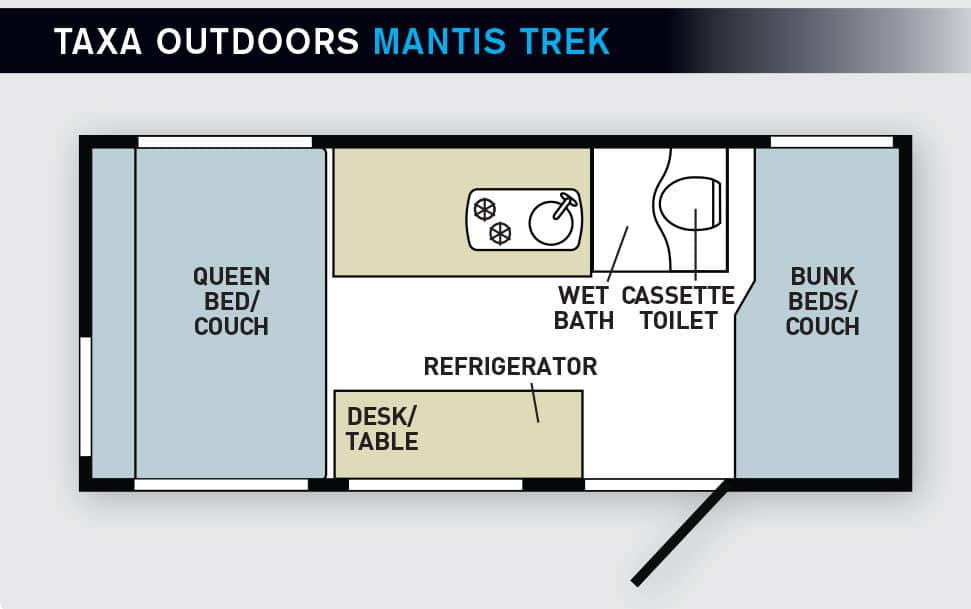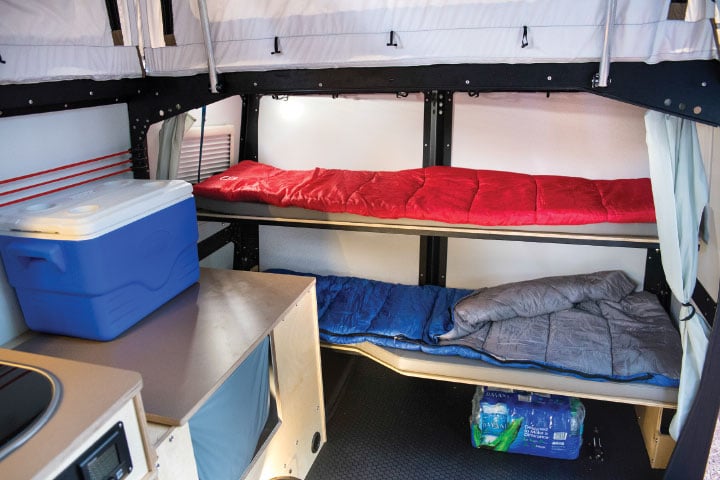Taxa Outdoors’ adventure-style Mantis Trek and GMC’s Canyon Denali diesel make an outstanding combo for off-grid camping
One of the beauties of owning a travel trailer is being able to bug out at a moment’s notice to escape the pressures of day-to-day life and relax somewhere quiet while still enjoying a comfortable shelter. For many outdoorsy types, myself included, the ideal getaway trailer needs to be light in weight so it can be towed easily by a four-wheel-drive SUV or a midsize pickup and small enough to tuck into tight spots. To have the freedom to camp wherever the road may lead, the trailer also needs to be self-contained and offer the conveniences of home, though pared down. And it doesn’t hurt if it has great eye-appeal.
Those are the very virtues that caught my attention when I saw the newest and largest offering in Taxa Outdoors’ lineup of adventure-style trailers, the Mantis Trek. Its “NASA-inspired” exterior design, with a subdued gray-and-matte-black paint scheme over an aluminum-skinned body, makes it look like the CIA might use it when setting up camp in some remote location. Drop down its four stabilizer legs and pop up the tented roof, and in silhouette it does, to some degree, resemble a praying mantis.
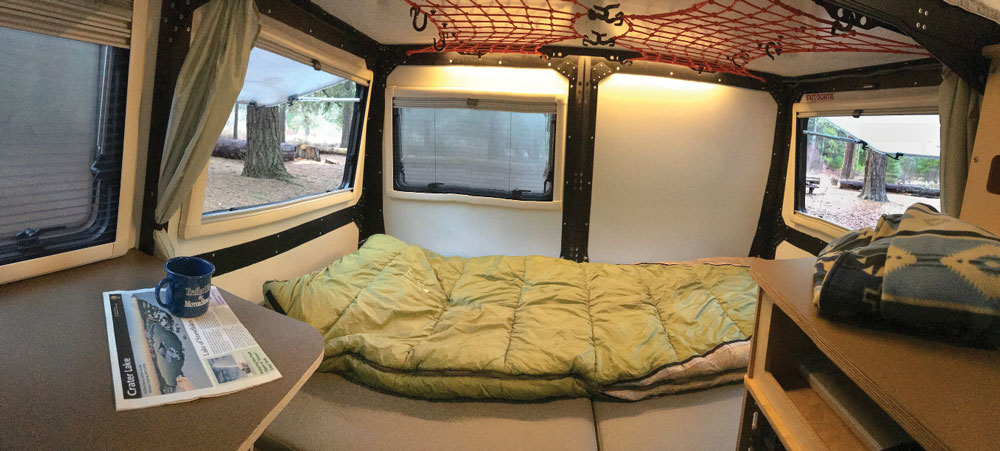
By folding down the split-back bench seat, the rear of the Taxa Mantis Trek becomes a queen-size bed.
The Mantis Trek weighs just shy of 3,000 pounds dry, and in travel mode measures 19 feet long and a couple inches under 7 feet high, making it an easy tow behind many of today’s SUVs, Jeeps and midsize pickups. Its sleek, low-profile design helps maximize towing fuel economy, while the pop-up roof provides ample interior headroom for moving around the living quarters.
The real test of a camping trailer is how it performs when it’s time to bug out, so my wife and I left the ’burbs for the boondocks, towing the Mantis Trek behind a new GMC Canyon Denali diesel. Our goal to disconnect from the hustle-and-bustle of the digital world for a few days took us to the eastern shoulder of the Oregon Cascades.
Light Touch
One of the interesting features we discovered while loading up the Mantis Trek is that it doesn’t have cabinets, drawers or a closet. In place of cupboards, it has cubbies cut into the marine-grade birch plywood along the back wall of the galley and under the countertops on both sides of the trailer’s midsection. It’s a storage design shared with many teardrops and expedition-type trailers.
Instead of drawers, six milk-crate-style containers slip into cubbies under the countertops and are secured by bungee cords. The honeycombed plastic crates make it easy to transfer food and camp gear from the house to the trailer, and they serve double duty as footrests and seats. It’s one of numerous weight-saving methods Taxa used in the trailer’s design, and it makes it easy to visually identify what’s in each storage spot.
The Mantis Trek also has ample storage in open sections hidden beneath the rear couch/double bed and forward sofa/bunk beds. These are ideal spaces to keep bulky items such as sleeping bags and backpacks. There’s also a web-type cargo net suspended beneath the ceiling above the rear bed to stow more clothing and light gear.
Bigger items can be secured on two roof-top racks (one front, one rear) that handle several hundred pounds of additional gear, such as a canoe, kayaks or cargo carriers. Bikes, jerry cans, folding chairs or whatever else might be needed on an extended camping adventure can also be secured to the rear rack that also serves as a sturdy, protective bumper.
Clearly, Taxa designed the Mantis Trek to accommodate the needs of those who prefer to travel loose and light in pursuit of outdoor adventure. We loaded up the crates, tossed in our sleeping bags and backpacks, filled the 2.8-cubic-foot Dometic 12-volt DC refrigerator-freezer, made sure the twin 5-gallon LP-gas cylinders on the A-frame were topped off and filled the 20-gallon freshwater tank. Time to hit the road.
 Camp Setup
Camp Setup
The Mantis Trek has all the requisite features to take advantage of full hookups or dry camping. The street side of the trailer has the freshwater-fill inlet, solar-panel plug receptacle, 30-amp 120-volt AC service receptacle, freshwater inlet, exterior shower hookup and the access panel to the cassette toilet that takes the place of a traditional blackwater tank. The test trailer was also equipped with twin Group 27 deep-cycle batteries and a 40-amp converter, so there was ample electrical power wherever the trailer came to rest.
In our case that was the Deschutes National Forest’s Lower Bridge Campground, about 10 miles downstream from Camp Sherman along the banks of Oregon’s famed Metolius River. Most of the spaces in this campground are relegated to tent camping, but a few sites can accommodate a 40-foot trailer-and-tow-vehicle combo.
We backed into a spot that was less than a dozen yards from one of the best fly-fishing rivers in America, and the Mantis Trek and GMC Canyon Denali fit with room to spare. I enjoyed the maneuverability of the combo, which has a small enough footprint to easily navigate over narrow gravel and dirt roads and into snug campsites.
Setting up the Mantis Trek is a no-brainer. You open the wide but low door, duck inside the trailer and release the pop-up tent roof’s two side latches. A moderate amount of forward and upward pushing instantly raises the interior ceiling height from 4 feet, 7 inches to nearly 8 feet at the highest point. Two hook-and-loop fasteners wrap around each
of the arms to keep them in place.
Rocker-style light switches near the entryway make it easy to turn on a variety of interior and exterior LED lights, while another fused panel on the face of the galley controls the water pump. That’s also where the digital controller for the Truma Combi space-and-water-heating system is located. We put the ultra-compact Combi’s 14,300-Btu furnace to the test on two nights camping along the river when temps unexpectedly dipped down into the mid-20s. Happy to say, it kept the Mantis Trek interior toasty.
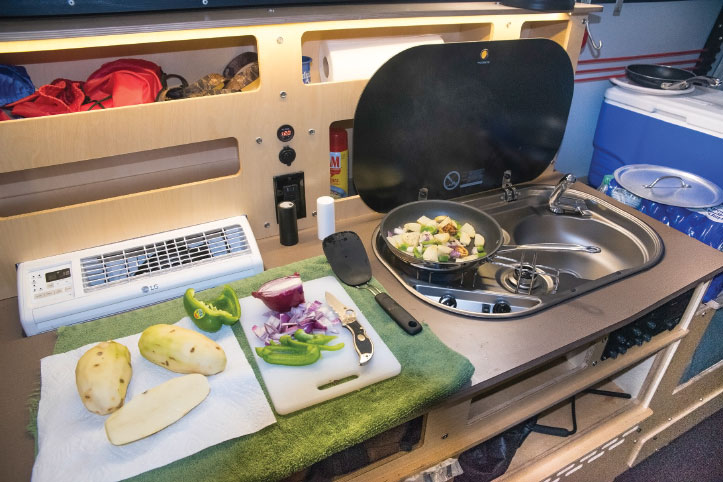
Made from marine-grade birch plywood,
the galley houses a two-burner Dometic stove-and-sink combo and offers more
than enough counter space for meal prep.
Should our trip have been in the heat of summer or in a hot, humid climate, the cross-ventilation afforded by the roof tent’s screened windows and the flip-open windows on the trailer’s hard sides would have kept us comfortable. If cross-ventilation isn’t enough and you’re plugged in to a 120-volt AC power source, the Mantis Trek comes with a built-in 6,000-Btu air conditioner that’s mounted on the galley countertop.
Beds and Bath
When it’s time to sack out, the Mantis Trek can easily sleep two adults on the convertible rear bench that spans the 6 feet, 10 inches between the insulated foam-core aluminum walls. The split-back seat folds flat into a queen-size bed that is plenty big for 6-foot-plus occupants to stretch out.
Although the pads that cushion the bench and converted bed look soft and inviting, looks can be deceiving. When we plopped down, we were greeted by a hard, firm surface. Fortunately, we had a couple of extra sleeping bags and a sleeping pad, which we laid on top of the cushions.
As for the bunk beds at the front end, the back of the bench flips up and latches to turn it into the upper bunk. The bunks are narrow, and the pads are just as firm as those in the rear, so anyone other than kids or a petite adult will probably find them uncomfortable. The sleeping space is also tight, both in width and height between bunks, requiring some agile moves to get into and out of a sleeping bag.
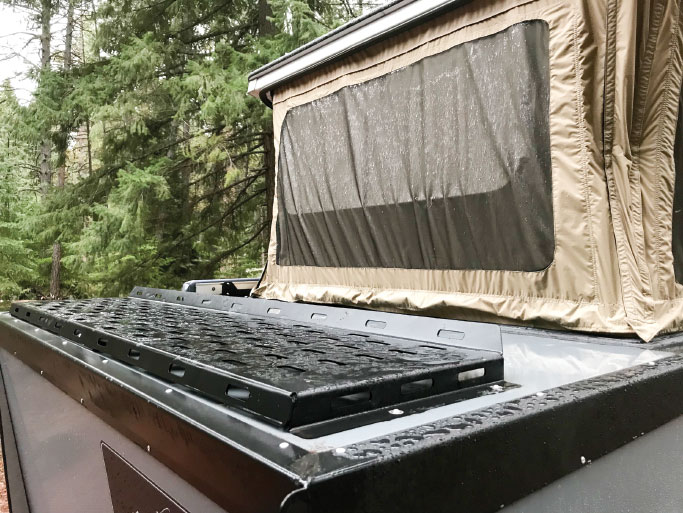
For transporting a cargo carrier or outdoor gear such as a canoe, kayaks or mountain bikes, the roof has steel racks in the front and rear.
We rose early to make a typical camp breakfast of home fries and eggs using the two-burner Dometic stove tucked beneath the glass top on the galley counter. The stainless sink and stovetop are one unit, and are easy to use, but I wished for a few more inches between the burners so cooking wasn’t limited to a 10-inch skillet on the larger burner and a little coffeepot on the smaller one.
RVers used to sharing a meal at a dinette will find eating in the Mantis Trek a bit different; the trailer doesn’t have a dedicated table or chairs. You place the dished-up food on a corner of the counter and sit on the rear bench or pull up a milk crate, or you pass the plate through the flip-open windows, as with a food truck, and eat outside.
It’s a very utilitarian arrangement not typically found in a $40,000 travel trailer but is typical on the serious adventure/overland-style camping trailers available today.
The bathroom setup is equally minimalistic. The Mantis Trek is equipped with the aforementioned electric-flush cassette toilet that is forward of the galley counter and hidden beneath a removable top. It’s cozy but functional. Not having a blackwater tank saves space and weight, and the cassette system makes it convenient when disposing of waste.
Taking a shower inside requires raising a plastic curtain that encloses the facilities. The Truma Combi water heater is a good one, so even a quick shower is enjoyable. The heavy black vinyl covering the inch-thick tongue-and-groove wood floor is impervious to water, as well as grime tracked in from outside.
We spent three days with the Mantis Trek and found it to be one of the easiest trailers of this size and type to tow, maneuver and set up. It’s well constructed inside and out, and has an interesting mix of design features shared among traditional travel trailers, teardrops and expedition-style trailers.
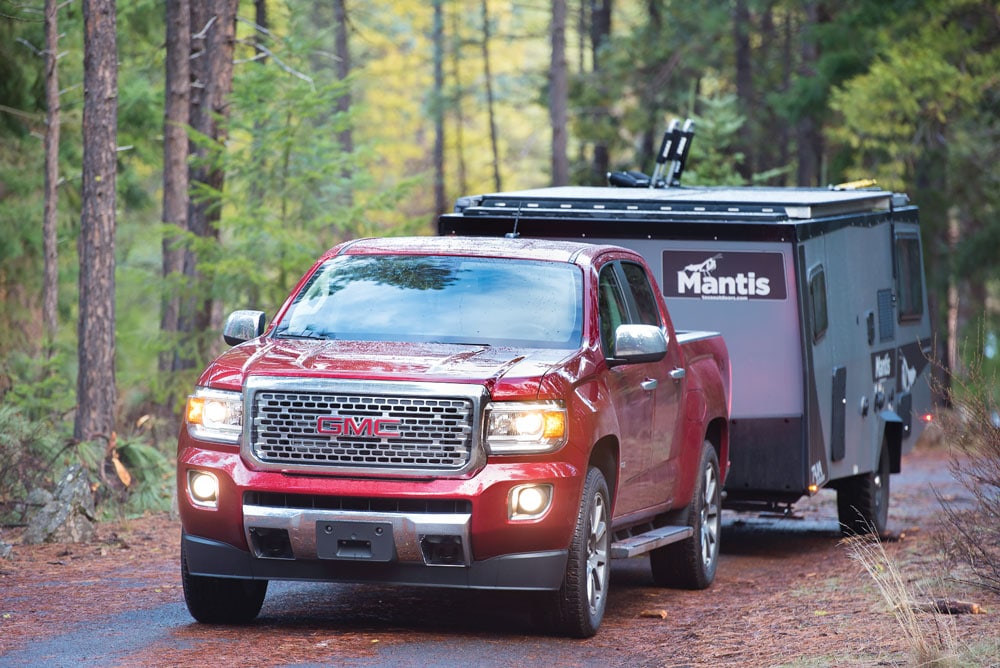
The Canyon Denali and Mantis Trek are small enough to get around on back roads and equipped to handle whatever conditions come their way.
Midsize Tow King
Having a well-equipped, nicely styled camping trailer to get away from it all is great, but it’s only part of the equation.
You need a vehicle that can get the trailer to your destination in a manner that makes the journey enjoyable and drama-free. GMC’s 2018 diesel Canyon Denali Crew Cab shortbed 4×4 does just that, as we learned firsthand during our time with the Taxa Mantis Trek.
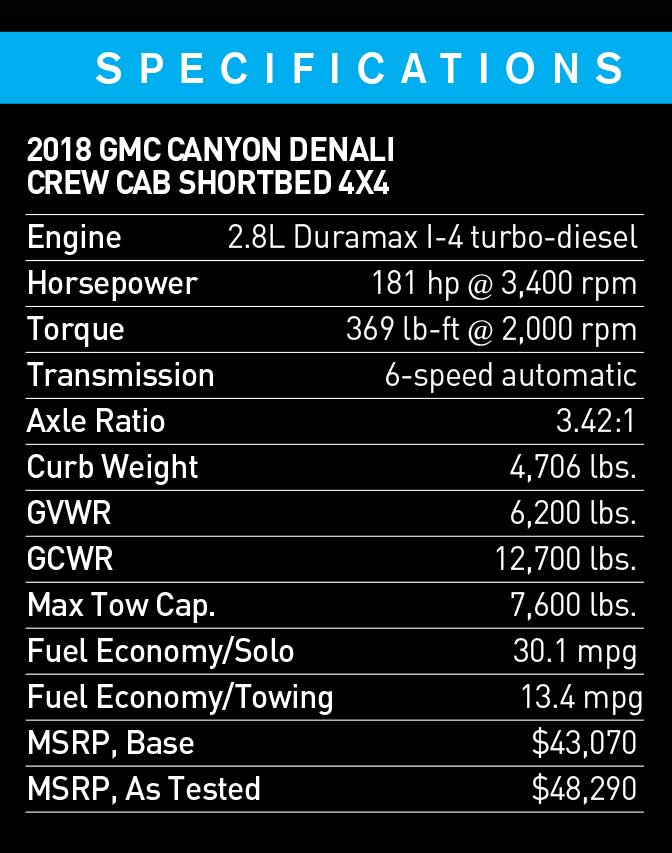 GMC’s diesel four-door is as sweet a tow vehicle as you’re going to find in the midsize-pickup segment. The 181-horsepower, 2.8-liter “baby” Duramax turbo-diesel has more pulling power than the 308-horsepower 3.6-liter gas V-6 that comes as the standard engine, and it delivers 10 percent better fuel economy.
GMC’s diesel four-door is as sweet a tow vehicle as you’re going to find in the midsize-pickup segment. The 181-horsepower, 2.8-liter “baby” Duramax turbo-diesel has more pulling power than the 308-horsepower 3.6-liter gas V-6 that comes as the standard engine, and it delivers 10 percent better fuel economy.
Tow power comes from torque, and the Duramax cranks out 369 lb-ft at 2,000 rpm, compared to the gas V-6’s 275 lb-ft at 4,000 rpm. The Denali-trim Canyon’s pulling power was put to the test towing across the Oregon Cascades and Coast Range passes. Not once did the 3,500-pound trailer feel like it was a burden, nor did we expect it to be, considering that this model Canyon has a max tow rating of 7,600 pounds. I loved the grade-braking and shift points of the diesel’s six-speed automatic.
The diesel’s pulling power comes alive when the tach rolls past 1,800 rpm, and the little Duramax inline-four pulls far stronger than the V-6. The four-wheel-drive Denali Canyon is also comfortable, quiet and fuel-efficient. We averaged 13.4 mpg towing the Mantis Trek and 30.1 mpg driving solo, a phenomenal figure for a pickup on the open road.
The shortbed crew cab rode and handled more like a luxury sedan than a truck and absorbed road irregularities with aplomb. The Denali trim provided all the amenities and latest safety features to keep us quite relaxed on our long camping trip with the Mantis Trek. The only upgrade we would have liked to have had on the Denali would be all-terrain tires instead of the street treads, which would have made our off-pavement drive time a little more relaxing.
Taxa Outdoors | 713-861-2540 | www.taxaoutdoors.com
GMC | 800-462-8782 | www.gmc.com
 A respected automotive and RV journalist and longtime Trailer Life contributor, Bruce W. Smith has held numerous editorial titles at automotive and boating magazines, and authored more than 1,000 articles, from tech to trailering. He considers his home state of Oregon a paradise for RVing and outdoor adventure.
A respected automotive and RV journalist and longtime Trailer Life contributor, Bruce W. Smith has held numerous editorial titles at automotive and boating magazines, and authored more than 1,000 articles, from tech to trailering. He considers his home state of Oregon a paradise for RVing and outdoor adventure.


